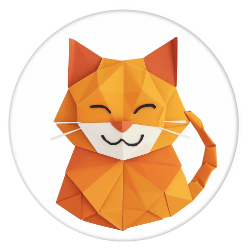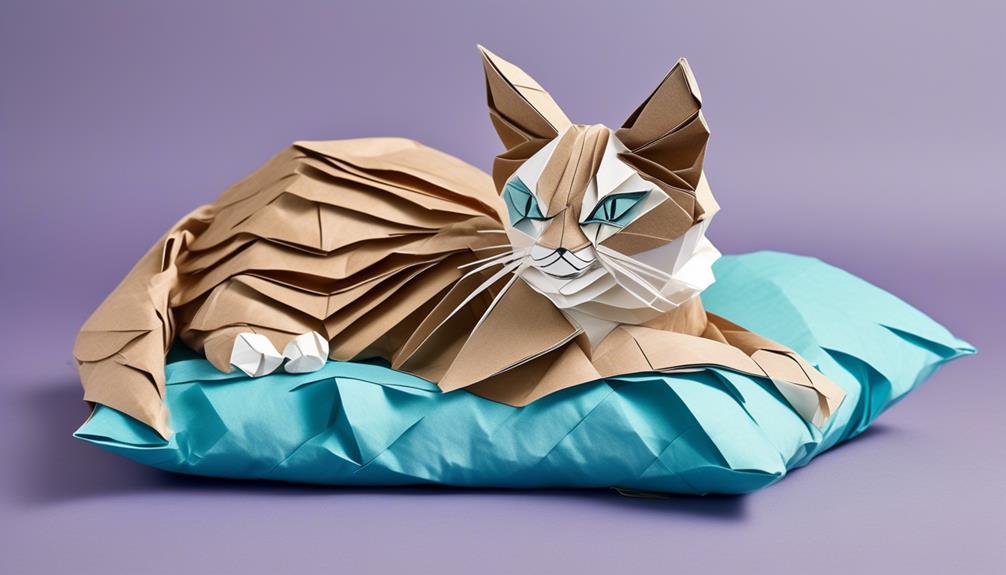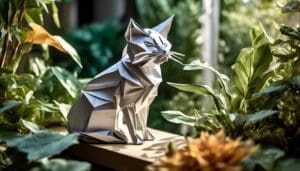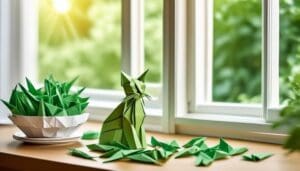Managing your older cat’s weight is important for their health and well-being. It involves a careful balance of proper nutrition, regular exercise, and affection.
You’ve seen them slow down a bit, and perhaps their once sleek coat has begun to feel a bit more, well, insulated. It’s clear that you care deeply about their health and happiness, and you’re looking for ways to help them shed those extra ounces that could make all the difference.
Here are 10 straightforward tips on how to help your elderly cat achieve a healthy weight suitable for their age and lifestyle.
Explore ways to help them reach a healthier weight without giving up the happiness and comfort of their golden years.
Key Takeaways
- Assess and monitor the cat’s current eating routine, including portions and treats, to ensure they are receiving appropriate nutrition and avoid overfeeding.
- Consult with a veterinarian to determine the ideal body weight and tailor a calorie-controlled diet for the senior cat.
- Gradually reduce daily food intake to manage weight without causing stress or risking hepatic lipidosis.
- Establish a balanced approach to treat intake and maintain a consistent feeding schedule to regulate appetite and prevent overeating.
Assess Current Diet
To ensure your elderly cat maintains a healthy weight, let’s carefully examine their current eating routine, from the portions they receive to the treats they cherish.
Senior cats have unique nutritional needs, and the right cat food is vital for their well-being. It’s important to assess not only the amount of food they’re getting but also the quality. Look at the cat food’s label to understand the nutritional content—protein, fat, and carbohydrates—and ensure it’s tailored for a senior cat. These nutrients are the building blocks for your cat’s health, and the best food for them may change as they age.
Pay attention to how often your cat is fed and the size of each portion. It’s easy to overfeed with love, but the right amount is crucial for weight control. Also, note their treat intake. While treats are a lovely way to bond with your cat, they should be given sparingly.
If you notice any shifts in their appetite, it could be a sign of underlying health issues, so don’t hesitate to consult your vet. They can provide guidance on the best food choices and help you adjust the feeding regimen to maintain your cat’s health and happiness.
Schedule Regular Check-ups
You know your cat’s health is precious, and regular vet visits are the cornerstone of keeping them in tip-top shape.
It’s during these check-ups that you’ll track their health progress and make necessary tweaks to their diet.
As your cat’s needs evolve with age, these appointments become vital to ensure their weight is managed lovingly and carefully.
Monitor Health Progress
Ensuring your elderly cat maintains a healthy weight involves scheduling regular veterinary check-ups for a thorough health assessment. Regular visits to the vet are crucial when your senior cat is on a weight loss journey. These check-ups help rule out any underlying health issues that could affect your cat’s well-being.
Your vet can determine the ideal body weight for your cat and tailor a calorie-controlled diet accordingly. It’s important to remember that weight loss goals for senior cats may start higher than their ideal weight, with plans to re-evaluate as progress is made.
That’s why it’s vital to keep up with regular check-ups, ensuring your cat’s health is always monitored and supported.
Adjust Diet Accordingly
After closely monitoring your senior cat’s health progress through regular veterinary visits, it’s equally important to adjust their diet to reflect their changing needs. In collaboration with your vet, tailor their meals to support their well-being as they age.
- Offer high protein foods to maintain muscle mass and support overall health.
- Transition to a senior diet specifically formulated for older cats’ nutritional requirements.
- Serve smaller meals more frequently to aid digestion and meet caloric needs gently.
- Include wet food to ensure proper hydration and reduce kidney strain.
- Embrace the bond you share by providing a diet that sustains their vitality and honors their golden years.
Your compassionate care and attentiveness make all the difference in your cherished cat’s life.
Caloric Intake Reduction
Reducing your elderly cat’s daily food intake gradually can help manage their weight without causing stress. Weight control is vital for their health and wellbeing, and caloric intake reduction is a compassionate step towards helping your cat lose weight safely. Consult with your veterinarian to determine the appropriate calorie intake for your cat, as they can provide a tailored plan suited to your cat’s needs.
To ensure you’re accurately managing their food portions, use a measuring cup. This simple step can make a significant difference in your cat’s weight control journey. Consider feeding your cat smaller, more frequent meals, which can help them feel satisfied throughout the day and prevent overeating.
Here’s a table to help you visualize the process:
| Strategy | Benefit |
|---|---|
| Gradual Food Reduction | Eases your cat into a new diet without sudden changes |
| Vet-consulted Calorie Intake | Ensures tailored, healthy weight loss |
| Smaller, Frequent Meals | Helps control hunger and maintain energy levels |
| Accurate Food Measurement | Prevents unintentional overfeeding |
| Regular Weight Monitoring | Tracks progress and effectiveness of caloric intake reduction |
Monitoring your cat’s weight regularly can track the effectiveness of these changes. Remember, you’re not just reducing numbers on a scale; you’re enhancing the quality of life for your cat.
Increase Hydration
Water is crucial for your older cat’s health, especially when managing their weight. Providing wet food and using a water fountain can improve their hydration.
We’ll explain how to use these methods and track your cat’s water intake to ensure they stay healthy.
Offer Wet Food Options
To support your aging cat’s health, consider incorporating wet food into their diet to enhance hydration and address potential kidney and urinary tract concerns. Wet food options can be a tender mercy for older cats, often more enticing and easier to consume if dental issues have made dry kibble a challenge.
By offering wet food options, you’re not just catering to their palate but also serving their physiological needs.
- Wet food can be a comforting treat, warming their heart as much as it satisfies their hunger.
- The soft texture allows for easier digestion, a gentle gesture for their aging body.
- Hydrating through their cat’s food can ease your worry about their water intake.
- Each meal becomes an opportunity for increased care and connection.
- Watching them relish their wet food offers peace of mind, knowing they’re content and cared for.
Water Fountain Benefits
Encouraging your elderly cat to stay hydrated, a water fountain may become a delightful source of both refreshment and amusement. The gentle flow of water can entice your senior friend to drink more frequently, reducing the risk of kidney disease—a common ailment in older felines.
Unlike a stagnant cat bowl, the running water in a fountain mimics a natural stream, appealing to your cat’s instincts.
Consider replacing the traditional water dish with a fountain to help your senior cat maintain proper hydration. Not only is this beneficial for their kidneys, but it also supports weight management in overweight cats. Adequate water intake can help them feel fuller, potentially curbing overeating.
Monitor Drinking Habits
Keeping an eye on your elderly cat’s drinking habits is essential for ensuring they stay properly hydrated. If your cat is losing weight, monitoring water intake is crucial. Changes in drinking patterns can signal underlying medical conditions, so don’t hesitate to contact your vet as soon as you notice anything amiss.
- Provide fresh, clean water in multiple accessible locations to encourage sipping throughout the day.
- Introduce a water fountain designed for cats, as the running water can stimulate interest.
- Add a splash of low-sodium chicken broth to their water for an enticing twist.
- Offer wet food, which has higher moisture content, to aid in hydration.
- Observe and track your kitty’s water consumption and discuss any concerns with your vet.
Your tender care makes all the difference in your elderly cat’s well-being.
Encourage Light Exercise
Regularly engaging your elderly cat in light play with toys they find irresistible can gently boost their activity levels and support weight management. You know your old cat’s preferences best; use toys that mimic their favorite prey.
A feathery wand or a mouse-like toy can make for an enjoyable and invigorating game. Laser pointers can also be a wonderful tool, as they tap into your cat’s natural hunting instincts and encourage light exercise without needing much space.
To inspire movement throughout the day, consider placing your cat’s meals in small containers scattered around the home. This not only encourages light exercise but also adds a bit of adventure to their routine. Introducing food puzzles can further stimulate their mind and body, keeping them engaged and active.
If your cat is comfortable with it, you might even explore the option of walking them on a harness. With patience and extended training, a harness walk can become a delightful way for your aging cat to experience the outdoors and stay fit. Remember, the goal is to encourage light exercise that’s both safe and enjoyable for your old cat.
Gradual Dietary Changes
When introducing your elderly cat to a new diet, it’s important to make the transition gradually over a 7-10 day period to ensure their comfort and well-being. Abrupt changes can be hard on your cat’s digestive system and may cause unnecessary stress. Remember, you’re not just changing their meals; you’re enhancing their quality of life.
As you begin the process of gradual dietary changes, consider the following carefully crafted steps designed to support your cat’s health and happiness:
- Mix a little love with care: Start by combining the new food with the old, slowly increasing the new food each day.
- Monitor closely, like a guardian: Watch your cat’s reaction to the new diet, adjusting if needed.
- Aim for balance, not speed: Adjust their intake to target a safe body weight per week loss.
- Prevent with patience: Gradual changes can help stave off hepatic lipidosis, a risk in obese cats.
- Embrace the journey together: Change is a path you’re both on; show them they’re not alone.
Your dedication to serving your elderly cat shines through these gentle adjustments. By taking it one step at a time, you’re not only preventing health issues but also paving the way for a loving and nurturing environment as they continue to age gracefully beside you.
High-Protein, Low-Carb Foods
As your cat ages, their dietary needs shift. A high-protein diet can be instrumental in sustaining their vitality.
By serving high-protein, low-carb cat foods, you’re helping to ensure that they feel satisfied longer after meals, which can prevent the tendency to overeat and subsequent weight gain.
These specially formulated foods not only assist in preserving lean muscle mass but also support a healthy metabolism, both of which are crucial for your cat’s overall wellbeing. It’s important to remember that not all cats’ food is created equal when it comes to managing the weight of an elderly cat. Excess carbohydrates can be particularly problematic, as they may lead to unnecessary weight gain in less active senior cats.
Before making changes to your cat’s diet, consulting with a veterinarian is always a wise move. They can provide personalized advice that caters to your cat’s specific needs, ensuring that any dietary adjustments contribute positively to their health.
Monitor Treat Intake
Monitoring your elderly cat’s treat intake is essential to prevent them from consuming too many calories and gaining unnecessary weight. As a devoted caregiver, you understand that weight control is pivotal for your cat’s health and vitality. By keeping a loving eye on their treat consumption, you’re not just managing their diet, you’re ensuring their golden years are filled with joy and playfulness, not burdened by the complications of obesity.
Here are some compassionate strategies to help you monitor treat intake:
- Limit treats to special moments, cherishing the bond you share.
- Choose low-calorie options that nourish without weight gain.
- Spread love, not just treats; affection is calorie-free.
- Be consistent; your cat relies on your steadfast care.
- Track treats like precious memories, each one special and not overdone.
By carefully selecting treats and moderating their intake, you demonstrate your love and commitment to your cat’s health and well-being, ensuring you both enjoy the journey together.
Create Feeding Schedule
You know how much your cat loves their mealtime, so setting a consistent feeding schedule is key to managing their weight.
Measuring each portion can prevent overfeeding, which is important as their metabolism slows down with age.
Keep an eye on snack frequency too, ensuring treats don’t disrupt their diet and overall health.
Consistent Meal Times
Establishing consistent meal times can significantly benefit your elderly cat by regulating their appetite and reducing the temptation to overeat. By creating a feeding schedule, you’re not just aiding in weight control—you’re providing the loving structure your cat thrives on.
- Bonding Time: Share precious moments during meal times, reinforcing your special connection.
- Peace of Mind: Know they’re getting the right amount of food, and rest easy.
- Happy Routines: Bring joy to their day with predictable and comforting meal times.
- Gentle Care: Adjust portions as needed for their health, showing your deep understanding.
- Observant Love: Monitor their intake, catching any issues early with your attentive care.
Your devotion to creating consistent meal times reflects the loving care you give, ensuring their golden years are as vibrant and healthy as possible.
Measure Food Portions
While setting consistent meal times lays the groundwork for your elderly cat’s weight management, measuring out food portions is just as critical to ensure they’re not consuming more calories than they need. Use a measuring cup to provide accurate servings of dry food, as recommended by your veterinarian. This precision helps prevent the risk of excess weight, which can be particularly harmful in their golden years.
Avoid the temptation to free-feed, which can easily lead to overeating. Instead, establish a feeding schedule that allocates specific times for your cat’s meals. If your lifestyle makes consistency challenging, consider an automatic feeder that can dispense measured portions at the right times, maintaining your cat’s diet regimen even when you’re not at home.
Your dedication to measuring food portions is a true act of care for your cat.
Monitor Snack Frequency
Integrating specific snack times into your elderly cat’s feeding schedule can significantly help in controlling treat frequency and maintaining their healthy weight. Cats often look forward to their snacks, but it’s crucial to monitor snack frequency to prevent those extra pounds from creeping up.
Here’s how you can keep an eye on their treats while still providing the love and care they deserve:
- Establish set snack times to discourage free-feeding and overindulgence.
- Include healthy, low-calorie options to satisfy their cravings without the guilt.
- Notice the joy in their eyes with every well-timed treat.
- Celebrate the small victories as you see positive changes in weight.
- Share these special moments, reinforcing your bond through mindful feeding.
Enrich Environment
To keep your senior cat’s mind sharp and body agile, consider transforming their living space into a playground of interactive toys, cozy perches, and intriguing puzzle feeders. An enrich environment isn’t just a luxury; it’s a necessity for your elderly cat’s weight control and overall well-being.
By offering various perches and hideaways, you help your cat to climb and explore, maintaining their muscle tone and satisfying their instinctual need for security.
Introduce puzzle feeders to make mealtime a brain game that keeps your cat engaged, encouraging them to work for their food and thus supporting mental and physical stimulation. This not only aids in weight management but also brings joy and excitement to their daily routine.
Ensure your cat has access to windows for basking in the sunshine and observing the outside world, which can be a great source of entertainment. Safe outdoor spaces, if possible, can add another dimension to their explorations.
Regularly rotate new toys and introduce various scents and textures to avoid boredom and maintain your elderly cat’s active lifestyle, essential for their happiness and health.
Frequently Asked Questions
How Do I Get My Senior Cat to Lose Weight?
Start with a vet visit to check for health issues, then introduce a balanced diet and fun activities to help them shed those extra pounds safely.
What Can I Give My Elderly Cat to Gain Weight?
To help your elderly cat gain weight, you can offer high-calorie, nutrient-rich foods, including kitten formula. Consult your vet for supplements and warm up wet food to entice their appetite.
Why Is My 15 Year Old Cat so skinny?
Your 15-year-old cat’s skinniness could stem from various health issues. It’s best you consult a vet to uncover the cause and ensure they’re receiving care tailored to their unique needs.
How Do You Treat Elderly Cats Losing Muscle Mass?
To combat your cat’s muscle mass loss, gently increase playtime and provide a high-protein diet. Regularly consult your vet for tailored advice and monitor changes with love and attentive care.




